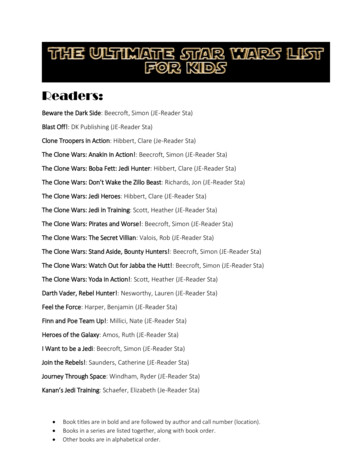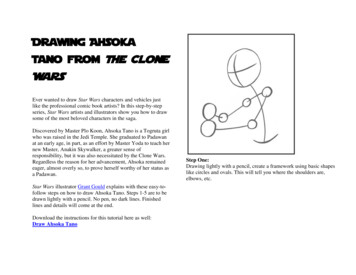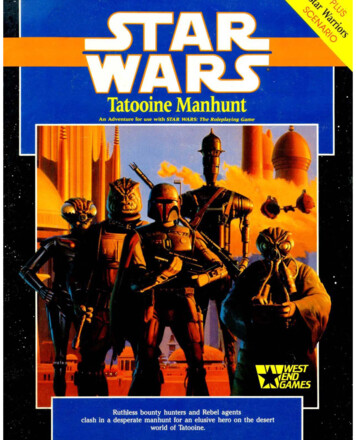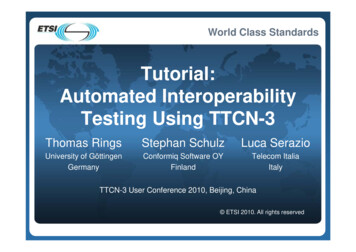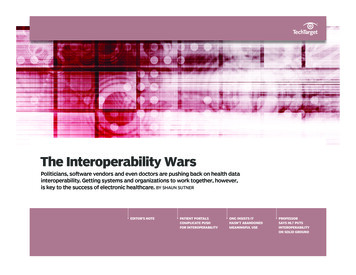
Transcription
The Interoperability WarsPoliticians, software vendors and even doctors are pushing back on health datainteroperability. Getting systems and organizations to work together, however,is key to the success of electronic healthcare. BY SHAUN SUTNEREDITOR’S NOTEPATIENT PORTALSCOMPLICATE PUSHFOR INTEROPERABILITYONC INSISTS ITHASN’T ABANDONEDMEANINGFUL USEPROFESSORSAYS HL7 PUTSINTEROPERABILITYON SOLID GROUND
EDITOR’SNOTEHOMEEDITOR’S NOTEPATIENT PORTALSCOMPLICATE PUSH FORINTEROPERABILITYONC INSISTS ITHASN’T ABANDONEDMEANINGFUL USEPROFESSORSAYS HL7 PUTSINTEROPERABILITYON SOLID GROUND2The Whole BallgameWithout health data interoperability,there’s no electronic path to patient transitions of care. There’s no health informationexchange. There’s no meaningful use of EHRs.And, perhaps most important, there’s noreining in the upward spiraling of healthcarecosts that every U.S. patient feels during openenrollment for health insurance plans.The ONC is fighting the good fight, alongwith its Centers for Medicare and MedicaidServices counterparts, building stage 3 ofmeaningful use and pushing former nationalcoordinator Karen DeSalvo’s 10-year plan forhealth data interoperability. But political andcommercial forces are pushing back. At somepoint, patients and politicians will see thewisdom of health data interoperability. At thatpoint, the tables of capitalism would tilt infavor of the patient, and one would think thatEHR vendors would work together for patients’sake to survive in the marketplace.THE INTEROPERABILITY WARSMeanwhile, CIOs are forced to build theirown connectors between competing healthdata systems with meager resources. In thisthree-part guide, we delve into this fractiousworld as it is today: One piece explores theinteroperability issues surrounding patientportals—whether they’re third-party applications or built into an EHR; another is an exclusive interview with DeSalvo from the recentAmerican Health Information ManagementAssociation annual convention; a third looksat one industry observer’s prescription forinteroperability aches: the latest versions of theinternational computer protocol for exchanginghealthcare data, HL7.With any luck, health data interoperabilityadvances will render this guide obsolete withinfive years. But we’re not holding our breath. nDon FluckingerNews Director, SearchHealthIT
TECHNOLOGYPatient Portals Complicate Pushfor InteroperabilityHOMEEDITOR’S NOTEPATIENT PORTALSCOMPLICATE PUSH FORINTEROPERABILITYONC INSISTS ITHASN’T ABANDONEDMEANINGFUL USEPROFESSORSAYS HL7 PUTSINTEROPERABILITYON SOLID GROUND3KSF Orthopedic Center was an earlyadopter of patient portal technology. Thepatient-to-doctor communication programsare at the heart of the nationwide push towardelectronic healthcare systems and form thebedrock for ONC’s patient engagement initiatives driven by meaningful use.When KSF installed its first patient portalthree years ago, the program was called Medfusion, the brainchild of North Carolina entrepreneur Steve Malik. But in 2010 Malik sold thecompany to digital consumer finance softwaregiant Intuit Inc., which renamed the portalIntuit Health as it grew and developed its features and interface.Malik bought his company back from Intuitin 2013.Kevin Harris, IT director of the 10-doctorHouston orthopedic clinic, is happy to haveit back and pleased that the words poweredby Medfusion are on the KSF-designed userTHE INTEROPERABILITY WARSinterface that patients use to view theirmedical records, request appointments andsend secure messages to their doctors.“Now it has that Intuit ‘click, click, click,’ butit’s got my website layout and color scheme,”Harris said. “Intuit picked it up and made itpretty, and it’s still pretty. It was a really goodride to be on.“But we’re really lucky to be back [with Medfusion],” Harris added, saying the connectionwith a smaller company seems to offer moreresponsiveness. “Now I can get Steve Malik onthe line when I need him.”STAYING TRUEMalik not only rebranded his original portalwith the original name—he’s also sticking tohis strategy of being a third-party add-on, analternative to the big EHR systems that comebundled with proprietary portals, such as Epic
TECHNOLOGYHOMEEDITOR’S NOTEPATIENT PORTALSCOMPLICATE PUSH FORINTEROPERABILITYONC INSISTS ITHASN’T ABANDONEDMEANINGFUL USEPROFESSORSAYS HL7 PUTSINTEROPERABILITYON SOLID GROUNDSystems’ MyHealth.For Harris’ part, he said grafting Medfusion to his GE EHR was easy, taking all of 90minutes.An alternative route, taken by other big EHRvendors, is to acquire a competing EHR thatbuilt its own portal, such as Malik’s formerbusiness partner, Allscripts Healthcare Solutions. Malik hit Allscripts with a lawsuit afterit bought Medfusion competitor Jardogs. Malikalleges Jardogs owes him several million dollarsfor breach of contract.Allscripts uses Jardogs’ FollowMyHealthto power its portal, just as it used to useMedfusion.Harris’ clinic uses GE’s Centricity EHR system but has declined to use GE’s built-in portalbecause he likes how Medfusion works more,particularly how Medfusion hosts the portal onits servers, relieving stress on his own servers.Harris noted that GE has worked amicably withMedfusion.“Medfusion puts everything on their end,” hesaid. “It provides a lot of ease.”WHEN DEVELOPERS, VENDORS TANGOIn an interview with SearchHealthIT, Malikapplauded Intuit’s stewardship and focus onconsumer ease of use. “Intuit is a great brand,”he said.Malik said Medfusion’s core market is nowphysician practices but the company “will continue to move upmarket” to larger healthcaresystems such as accountable care organizations.Malik continues to tout his device- andoperating system-agnostic approach. His company, he said, focuses on simple implementation of Medfusion with any EHR.He’s also not reluctant to take shots atAllscripts, even with a lawsuit pending.“We had a contract they didn’t abide by,” healleged. “Frankly, they weren’t paying us.”Meanwhile, Malik is aggressively pursuingAt the heart of the push toward electronic healthcare is patient portaltechnology—the bedrock for ONC’s patient engagement initiatives.4THE INTEROPERABILITY WARS
TECHNOLOGYHOMEEDITOR’S NOTEPATIENT PORTALSCOMPLICATE PUSH FORINTEROPERABILITYONC INSISTS ITHASN’T ABANDONEDMEANINGFUL USEmany of the physician practices that once usedhis portal, in an attempt to get them off FollowMyHealth and back on Medfusion.“In regards to Medfusion, Allscripts does notrespond to outstanding litigation,” Allscriptsspokeswoman Concetta DiFranco said in anemail. “Our focus is, as always, on our clientsand providing them with the best possible population health and healthcare information technology solutions.”Phil Kahn, interim CIO at UMass MemorialHealth Care in Worcester, Mass., an AllscriptsJardogs customer, said integrating any patientPROFESSORSAYS HL7 PUTSINTEROPERABILITYON SOLID GROUND5THE INTEROPERABILITY WARSportal into a big organization like UMassMemorial sometimes is a challenge when itcomes to making it work easily on iPhones andAndroid devices and across different operating systems. He also said that interoperabilitycomplications crop up in other health datasystems besides EHRs; they’re not confinedto mobile devices and patient portals.That being said, Kahn said FollowMyHealthworks well with the Allscripts EHR and itssecure messaging function has made it easierfor the hospital system to attest to meaningfuluse stage 2 patient portal measures. n
POLICYONC Insists It Hasn’t Abandoned Meaningful UseHOMEEDITOR’S NOTEPATIENT PORTALSCOMPLICATE PUSH FORINTEROPERABILITYONC INSISTS ITHASN’T ABANDONEDMEANINGFUL USEPROFESSORSAYS HL7 PUTSINTEROPERABILITYON SOLID GROUND6With most of the health IT world pushingfor a slowdown in the drive toward meaningful use stage 2, former National Coordinatorfor Health IT Karen DeSalvo, M.D., maintainedthat she and ONC remain committed to themeaningful use program even as the ONC hasfocused nearly all its efforts in recent monthson interoperability.DeSalvo said she believes ONC’s new“interoperability roadmap” and other planningmoves are laying the groundwork for sustainedfederal support for health IT initiatives in public and private healthcare settings through theend of the Obama administration in 2016 andbeyond.“Meaningful use is necessary but not sufficient” to stimulate IT development in healthcare systems, DeSalvo told SearchHealthITin an interview after her keynote address atthe general session of the 2014 AmericanHealth Information Management AssociationTHE INTEROPERABILITY WARS(AHIMA) Convention and Exhibit.DeSalvo said that as she travels around thecountry she sees some healthcare systems succeeding in the race to attest to meaningful usestage 2 this year, while others are struggling.Meanwhile, a coalition of health IT advocacygroups—notably, not including AHIMA—have asked Congress to pass legislation thatwould shorten the meaningful use attestationperiod next year from 365 days to 90 days.“They’re having a hard time solving it, but itreally matters for the patients,” DeSalvo said ofmeaningful use measures that require patientsto view their own medical records and providers to be able to transmit records electronically.“There have been some technical challenges.”‘HEALTH IT IS BIPARTISAN’In her address to some 2,000 AHIMAattendees, her first to the influential health
POLICYHOMEEDITOR’S NOTEPATIENT PORTALSCOMPLICATE PUSH FORINTEROPERABILITYONC INSISTS ITHASN’T ABANDONEDMEANINGFUL USEPROFESSORSAYS HL7 PUTSINTEROPERABILITYON SOLID GROUND7information management directors, DeSalvo—who left her post in October to become HHSacting assistant secretary for health—drewlaughs when she introduced herself: “I’m fromthe federal government and I’m here to help.”She noted that ONC was created a decade agoduring the Bush administration, which she saidsupported digitizing healthcare. Since then,she said ONC has made strides in establishinghealth information exchanges in all 50 states,spurred health IT efforts in poor rural areas,and helped oversee what she called “tremendous adoption” of EHRs and meaningful useduring stage 1 and even in stage 2.Near the end of her term, though, DeSalvoappeared to be making conciliatory gesturestoward EHR vendors, CIOs and other groupsthat insist that meaningful use is too difficultto achieve in a short time frame.“We really want to make sure the next policyof this program is an advancement but doesn’tcrush medicine along the way,” she told thecrowd.In the interview with SearchHealthIT,however, DeSalvo said she is convinced thatmeaningful use is well established and willTHE INTEROPERABILITY WARSmove on to stage 3 as planned. Furthermore,she asserted that by drawing a broad range ofconstituencies into planning for interoperability, including setting health data standards,momentum for progress in health IT will continue beyond 2016 whether it’s under anotherDemocratic administration or a Republicanone.“This administration and this presidentreally understand health IT,” she said in theinterview. “But I absolutely believe that healthIT is bipartisan. What I see evolving is a technology policy framework that gets us beyondEHRs.”SETTING FEDERAL DATA FREETo the AHIMA members, DeSalvo emphasizedONC’s efforts to promote interoperability whileprotecting patient privacy and data security.She also expressed support for data governance, AHIMA’s main policy goal over the nextyear, as well as for entrepreneurial trends suchas consumer wellness devices; she noted shewears a fitness tracker herself.Among those efforts is a campaign to update
POLICYHOMEEDITOR’S NOTEPATIENT PORTALSCOMPLICATE PUSH FORINTEROPERABILITYONC INSISTS ITthe federal health strategic plan, which includescoordinating IT strategy among some of thebiggest federal agencies, such as the VeteransAdministration, Department of Defense, SocialSecurity Administration and Centers for Medicare and Medicaid Services, among others.“The data has been captured very well, butit’s sticking in silos very often,” she said.As for data governance, DeSalvo told SearchHealthIT that the rapidly evolving practice willnot only help locate health information in complex systems but also “set the rules of the roadHASN’T ABANDONEDMEANINGFUL USEPROFESSORSAYS HL7 PUTSINTEROPERABILITYON SOLID GROUND8THE INTEROPERABILITY WARSin the public and private sectors for the collection and use of the data.”In the meantime, DeSalvo reiterated her support for meaningful use as a still viable policyand suggested that ONC’s efforts to spur thesetting of health IT standards for interoperability will go hand in hand with it.“We’re going to focus on the meaningful useportfolio to keep standardizing,” she said. “Weneed to standardize—and do it fast. EveryoneI’ve spoken to, including developers, wants todo this.” n
CHALLENGESProfessor Says HL7 Puts Interoperabilityon Solid GroundHOMEEDITOR’S NOTEPATIENT PORTALSCOMPLICATE PUSH FORINTEROPERABILITYONC INSISTS ITHASN’T ABANDONEDMEANINGFUL USEPROFESSORSAYS HL7 PUTSINTEROPERABILITYON SOLID GROUND9While interoperability may be one ofthe toughest challenges facing healthcare IT,providers struggling with how to port electronic health data from one system or platformto another shouldn’t feel all alone—exchangingdigital information has long bedeviled variousbusinesses.“As computer professionals, we’ve been dealing with these problems for more than twodecades,” said Lixin Tao, chair of the computerscience department at Pace University’s Westchester, New York, campus, during a presentation on overcoming interoperability issues atthe mHealth Telehealth World 2014 conference in Boston.Nonetheless, healthcare lags considerablybehind other sectors when it comes to solvingthose problems, Tao said.The professor’s tips hewed to the technical side, but his roadmap was vendor-agnostic,instead relying on solidifying interoperabilityTHE INTEROPERABILITY WARSefforts around versions 2 and 3 of Health LevelSeven (HL7), the international computer protocol for exchanging clinical and administrativehealthcare data.According to Tao, HL7’s interoperabilitystandards can help improve healthcare deliveryby optimizing workflows, reducing ambiguity and enhancing knowledge transfer betweenproviders, government agencies, standardsorganizations, vendors and patients.There are some issues to be aware of, though.Tao noted that HL7 v2 is the most popularinteroperability standard in healthcare IT, withadvantages including backward compatibility,so messages based on older version 2.x releasescan be understood by later ones. But the26-year-old specification is aging.HL7 v3 is more powerful, based on a modeldriven methodology designed to streamlineimplementation planning and better supportconformance testing. But it’s still evolving and
CHALLENGESHOMEEDITOR’S NOTEPATIENT PORTALSCOMPLICATE PUSH FORINTEROPERABILITYONC INSISTS ITHASN’T ABANDONEDMEANINGFUL USEisn’t backward compatible with v2, Tao said.In addition, shifting to the new version of thestandard “is a major migration” that is likely tobe “very expensive” for hospitals, clinics andother medical facilities, he said. As a result,most organizations are still using the morefamiliar v2 protocol.More generally, Tao expressed impatiencewith the pace of EHRs implementation,which he attributed in large part to a lack ofstandards.“We lack a solid semantic foundation for alot of these technologies,” he said. “We need aPROFESSORSAYS HL7 PUTSINTEROPERABILITYON SOLID GROUND10THE INTEROPERABILITY WARS[standard] that can embrace the diversity andallow different data formats to co-exist.”In a brief interview with SearchHealthITafter his presentation, Tao said the biggeststep healthcare organizations could take stillis moving away from paper records and handwritten notes. And, he said the government’srole in providing incentives is critical to theshift.One attendee, a physician and CIO, joked thathe would love to take advantage of the researchexpertise of Tao and his Pace colleagues. “Butit’s too expensive,” he said. n
ABOUTTHEAUTHORSHAUN SUTNER, a journalist with more than 25 years ofHOMEnewspaper experience, reports on information technologyissues for SearchHealthIT. Sutner’s newspaper careerincluded investigative reporting and coverage of theMassachusetts Statehouse and politics for the WorcesterTelegram & Gazette. Email him at ssutner@techtarget.com or follow him on Twitter: @ssutner.The Interoperability Wars is aSearchHealthIT e-publication.Scot Petersen Editorial DirectorEDITOR’S NOTEJason Sparapani Managing Editor, E-PublicationsPATIENT PORTALSJoe Hebert Associate Managing Editor, E-PublicationsCOMPLICATE PUSH FORINTEROPERABILITYDon Fluckinger News DirectorONC INSISTS ITShaun Sutner News and Features WriterHASN’T ABANDONEDAlex DelVecchio Site EditorMEANINGFUL USELinda Koury Director of Online DesignPROFESSORSAYS HL7 PUTSNeva Maniscalco Graphic DesignerINTEROPERABILITYStephanie Corby Publisher scorby@techtarget.comON SOLID GROUNDTechTarget275 Grove Street, Newton, MA 02466www.techtarget.com 2014 TechTarget Inc. No part of this publication may be transmitted or reproduced in any form or by any means without written permission from thepublisher. TechTarget reprints are available through The YGS Group.STAY CONNECTED!Follow @SearchHealthIT today11THE INTEROPERABILITY WARSAbout TechTarget: TechTarget publishes media for information technologyprofessionals. More than 100 focused websites enable quick access to a deepstore of news, advice and analysis about the technologies, products and processes crucial to your job. Our live and virtual events give you direct access toindependent expert commentary and advice. At IT Knowledge Exchange, oursocial community, you can get advice and share solutions with peers and experts.COVER ART: FOTOLIA
three years ago, the program was called Medfu-sion, the brainchild of North Carolina entrepre-neur Steve Malik. But in 2010 Malik sold the company to digital consumer finance software giant Intuit Inc., which renamed the portal Intuit Health as it grew and developed its fea-tures and interface. Malik bought his company back from Intuit in 2013.




